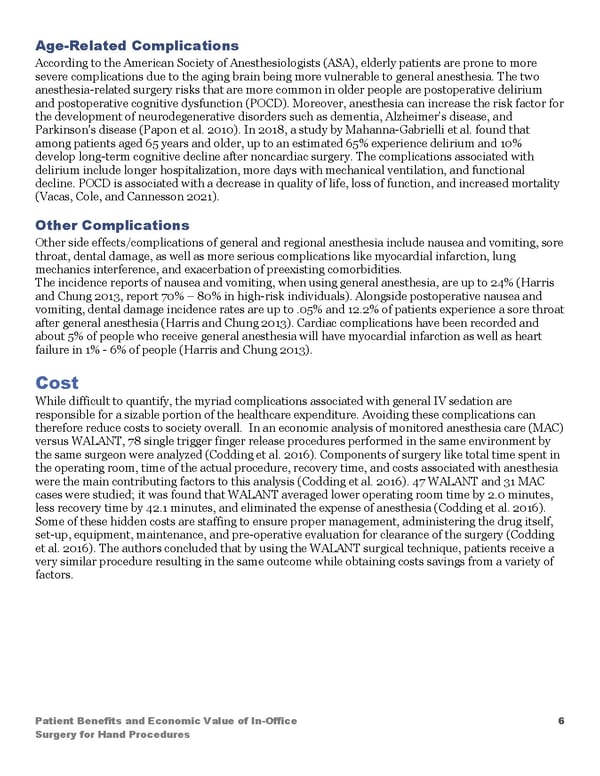Age-Related Complications According to the American Society of Anesthesiologists (ASA), elderly patients are prone to more severe complications due to the aging brain being more vulnerable to general anesthesia. The two anesthesia-related surgery risks that are more common in older people are postoperative delirium and postoperative cognitive dysfunction (POCD). Moreover, anesthesia can increase the risk factor for the development of neurodegenerative disorders such as dementia, Alzheimer’s disease, and Parkinson's disease (Papon et al. 2010). In 2018, a study by Mahanna-Gabrielli et al. found that among patients aged 65 years and older, up to an estimated 65% experience delirium and 10% develop long-term cognitive decline after noncardiac surgery. The complications associated with delirium include longer hospitalization, more days with mechanical ventilation, and functional decline. POCD is associated with a decrease in quality of life, loss of function, and increased mortality (Vacas, Cole, and Cannesson 2021). Other Complications Other side effects/complications of general and regional anesthesia include nausea and vomiting, sore throat, dental damage, as well as more serious complications like myocardial infarction, lung mechanics interference, and exacerbation of preexisting comorbidities. The incidence reports of nausea and vomiting, when using general anesthesia, are up to 24% (Harris and Chung 2013, report 70% – 80% in high-risk individuals). Alongside postoperative nausea and vomiting, dental damage incidence rates are up to .05% and 12.2% of patients experience a sore throat after general anesthesia (Harris and Chung 2013). Cardiac complications have been recorded and about 5% of people who receive general anesthesia will have myocardial infarction as well as heart failure in 1% - 6% of people (Harris and Chung 2013). Cost While difficult to quantify, the myriad complications associated with general IV sedation are responsible for a sizable portion of the healthcare expenditure. Avoiding these complications can therefore reduce costs to society overall. In an economic analysis of monitored anesthesia care (MAC) versus WALANT, 78 single trigger finger release procedures performed in the same environment by the same surgeon were analyzed (Codding et al. 2016). Components of surgery like total time spent in the operating room, time of the actual procedure, recovery time, and costs associated with anesthesia were the main contributing factors to this analysis (Codding et al. 2016). 47 WALANT and 31 MAC cases were studied; it was found that WALANT averaged lower operating room time by 2.0 minutes, less recovery time by 42.1 minutes, and eliminated the expense of anesthesia (Codding et al. 2016). Some of these hidden costs are staffing to ensure proper management, administering the drug itself, set-up, equipment, maintenance, and pre-operative evaluation for clearance of the surgery (Codding et al. 2016). The authors concluded that by using the WALANT surgical technique, patients receive a very similar procedure resulting in the same outcome while obtaining costs savings from a variety of factors. Patient Benefits and Economic Value of In-Office 6 Surgery for Hand Procedures
 Patient Benefits and Economic Value of InOffice Surgery for Hand Procedures Page 5 Page 7
Patient Benefits and Economic Value of InOffice Surgery for Hand Procedures Page 5 Page 7